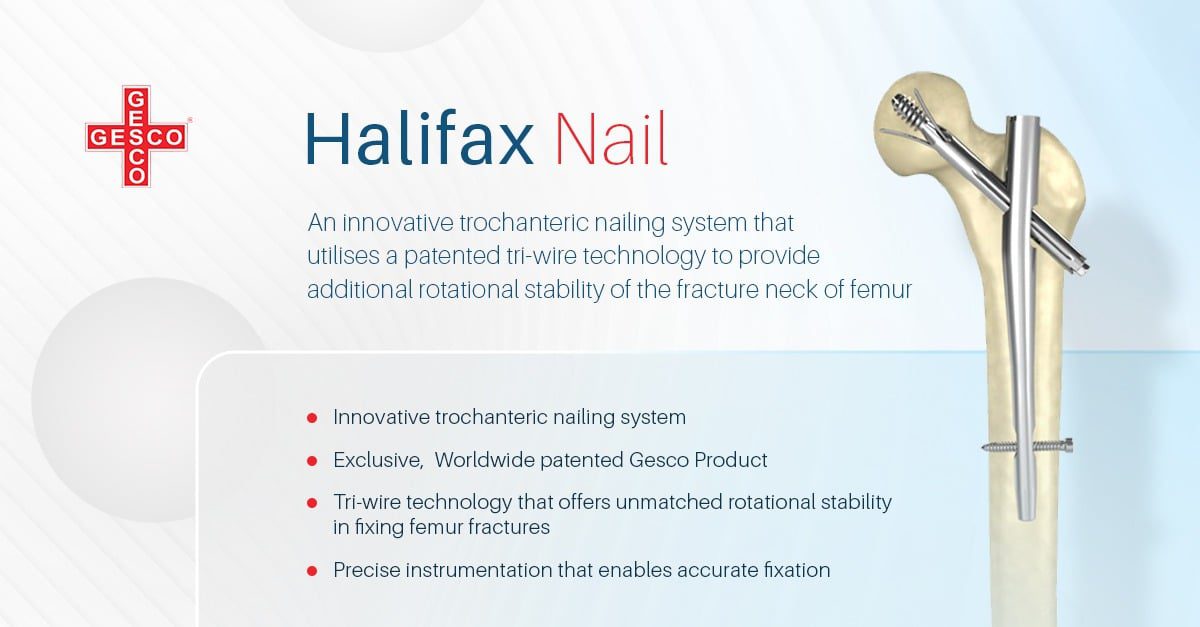Trauma implants are used in surgeries to repair broken bones, fractures and in surgeries to treat tumors that involve the arms, skull, legs and shoulders. Like any other surgical implants, trauma implants decrease the pain related to the joints and bones and significantly increase the mobility of the joints.
Trauma implants are often used in patients who have varying degrees of movement impairment as a result of wounds, unintentional injuries, and sometimes just the natural ageing process. When a doctor examines the patient and determines that the problem can only be remedied through trauma implant surgery, which involves augmenting or replacing the affected body part or joint, an orthopedic trauma implant is used. These surgeries are carried out by skilled surgeons with the highest levels of medical specialty. When a joint is injured beyond a certain point, it must be surgically separated and replaced with an orthopedic implant.
Gesco Healthcare manufactures high-quality trauma implants which enable patients to resume their normal lives.
Types of Trauma Implants
Locking Plates
They consist of distal femur locking plates, locking compression plates, philos plates with locking systems, and reconstruction locking plates. These plates for trauma implants must be produced with a great deal of skill and experience.
Non-Locking Plates
Dynamic compression plates, olecranon plates, DHS plates, L buttress Plates, and one-third tubular are examples of non-locking plates.
Interlocking Nails
Femoral, tibial, humeral, and proximal femoral nails are among the interlocking nails.
Bone Screws
It includes bone screws such as cortical screws, malleolar screws, cancellous screws, and screws with locking or non-locking heads.
Considerations while using Trauma Implants in Surgeries
- Trauma implants need to be produced, and implanted with the utmost care. However, when screws or plates support a greater amount of the weight on the bone, stress shielding is seen. Utilizing low-modulus materials, such as titanium and its alloys, can mitigate this issue but cannot completely solve it.
- The heat generated by the friction of the installed materials might build up and harm the bone tissues, which in turn lessens the strength of the connections that are made.
- Corrosion of any kind, including galvanic corrosion, is possible if dissimilar metals are put in close proximity to one another and are allowed to come into direct contact. The metal ions produced might harm the bone and have a negative impact on it.
- There are certain considerations that must be taken into account for children. Growth plate damage and greenstick fractures carry higher risks for children whose bones are still developing. The greenstick fracture can happen for the straightforward reason that a child’s bone is less fragile than an adult’s. As a result, they do not completely fracture; nevertheless, they do bow without the cortex of the bone being damaged.
- To ensure that the bone continues to expand and nurture appropriately, growth plate injuries require thorough and accurate treatment.
Trauma implant removal
It has always been a contentious topic to discuss whether implants should be removed after healing. There are several difficulties related to the removal. Trauma implant removal frequently necessitates a second opinion procedure since it may result in the formation of scar tissue and may also impede nerve function.
When it comes to removal of trauma implants in children, it is crucial to explant them once the healing is over for the sake of their development and the early phases of their bone-building process.
Quality Manufacturing and Testing of Trauma Implants
Trauma implants have unique indications based on criteria like bone size, and their use varies depending on the severity of the injury and the intended purpose of the procedure. Most of the trauma implants are manufactured in titanium and stainless steel.
Manufacturers of medical equipment for doctors and patients are now aware of the importance of using high-quality materials in their products’ construction. Long-term durability and reliability are now requirements.
In order to guarantee the same, trauma implants that are manufactured at Gesco Healthcare go through several testing procedures before being delivered to the market and receiving industry certifications.
- The materials used in trauma implants are thoroughly tested right from the raw material state to when they are cleaned and packaged.
- Physical, chemical, and corrosion-resistant properties are examined and correctly checked by the finest testing standards and procedures.
With its strong brand presence and wide offering, Gesco Healthcare is one of the leading market players in the manufacturing and exporting of Trauma Implants. Its strong dominance in this market is due to their consistent investments in its R&D facilities and delivering affordable high-quality implants. Moreover, a strong partnership with OEMs in USA and European markets enables them to expand its footprint across the world.

